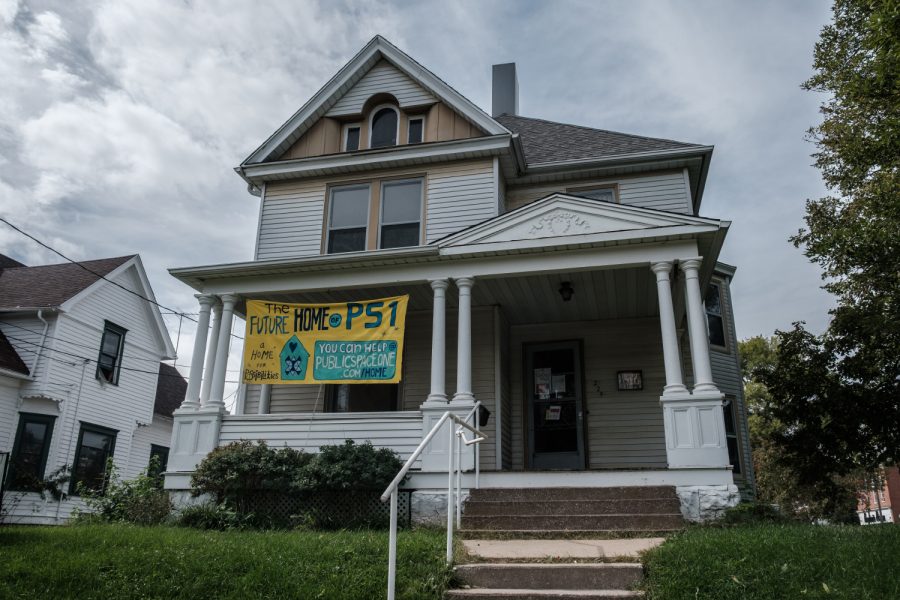‘Too Cute!’ art exhibition opens at PS1
This Saturday, Iowa City’s Public Space One opened its July art gallery that honors all things cute — pastels, puppies, and anything miniature — but organizers say there is a dark side to cute art.
Public Space One is seen at the new location on North Gilbert Street on Thursday, October 3, 2019. PS1 previously resided in the bottom floor of the Wesley Student Center.
July 5, 2021
Iowa City art lovers congregated at Public Space One on Saturday to celebrate the opening of its month-long art exhibition, “Too Cute.”
And the Saturday crowd was a cute one. In the driveway of the old home, a woman with pink hair served cotton candy, while groups of young friends sat mingling on the home’s front porch. Children were rolled in on wagons by their parents and techno music filled the hot air.
The indoor space was everything the gallery title promised it would be: too cute. From the ceramic toilet studded in charms and jolly ranchers, to the white cotton cloud decorated with rose petals and fake candy, Public Space One was a joyful look into what 13 local and nonlocal artists have been up to the past year.
Upon walking in, one of the first commanding pieces is Sam Hensley’s, “Mr. Beautiful,” an odd but enticing little creature made of colorful reclaimed fabrics and electronics. He walked around and chatted in a robotic voice to visitors.
Alongside Mr. Beautiful, the first room of the gallery held pieces that were for the most part, objectively cute. The second room held slightly more disturbing undertones. Vulva-esque drawings by Fuko Ito adorned one wall while Tommy Santee Klaws’s sad looking dogs cover the other. Creatures like Mr. Beautiful were placed on the floor, including “Gut Baby,” an awkward pink mesh creature also created by Hensley.
“Gut baby’s just proud to be Gut Baby,” said gallery organizer Vero Rose. “Beautiful and disturbing at the same time. And I love that, and I love how Gut baby moves in the world.”
Related: Public Space One turns outdoor space into snow-proof art display
Despite the cuteness, gallery organizers Drake Wilbur and Rose said there’s more to each piece than meets the eye. Although they have chosen to celebrate cuteness this July, art typically deemed “cute” by viewers often holds a darker connotation.
“I was really interested in the genderedness of cute and the complexion of cute with diminutiveness, smallness, attractiveness,” Rose said. “What happens when cute is also slightly sinister, or depressing, or deals with real serious issues in the world? Can cute also be high art?”
Vero Rose is a UI alum, artist, educator, and curator based out of Chicago. Rose spoke about her experiences living as both a hyper femme woman and female artist; she’s “too cute” to be queer, and “too cute” for her art to be taken seriously. Though her work aims to tackle pressing issues like climate change and historical and economic inequalities, it often gets dismissed as cute — a problem she says is common to both queer and female creators.
Rose and her co-organizer Drake Wilbur sought to explore the ways in which cute has been used as a weapon to silence and dismiss the intellectual work of artists who, oftentimes, didn’t intend for their work to be cute.
“Particularly in the work that I produce in other parts of my practice, around climate change, around big societal issues — I make a lot of small forms just because of the studio space I’ve had available to me for the past couple of years, and that smallness gets considered cute sometimes,” Rose said. “And I’m like, but no, this is about how we’re killing the planet, and destroying humanity’s future.”
While much of the art in the gallery can be perceived as cute at face value, many of the pieces deal with heavier themes. While Tommy Santee Klaws’ dog paintings in the gallery might seem cute and light-hearted to an onlooker, his work grapples with his childhood and familial trauma. Hannah Song’s brilliantly detailed ceramic cake, while adorable, is connected with disordered eating and overcoming that.
“Cuteness is also a weapon, like sometimes ‘cute’ can get you interested, like if there’s an aesthetic hook that can bring you into deeper issues,” Rose said. “Tommy Santee Klaws’s [art] is about familial connections that is presented in a way that is non-threatening because they can read as cute, right? So how can cute be empowering? How can we use cute as a way into deeper discussions?”
In hopes to garner a more serious response to the cute art, Wilbur and Rose placed the pieces into a more traditional gallery. Wilbur said it was his way of declaring that aesthetically cute art is just as important as what is typically perceived as “fine art.”
Despite the dark twist and deeper meanings, the air was happy that day. Children were wheeled away in the wagons they arrived in, and a bottle of champagne was popped in the driveway. Rose left with a final message:
“Stay cute. Stay queer,” she said.



